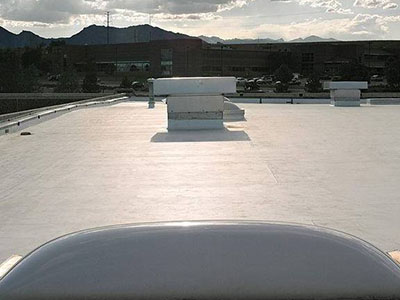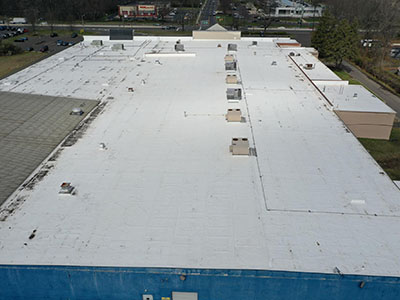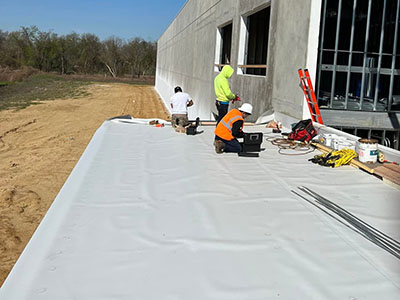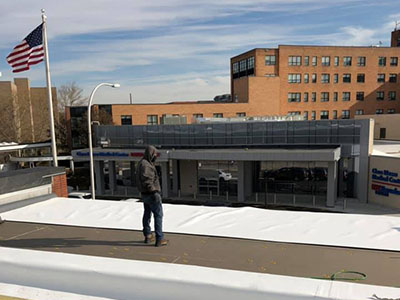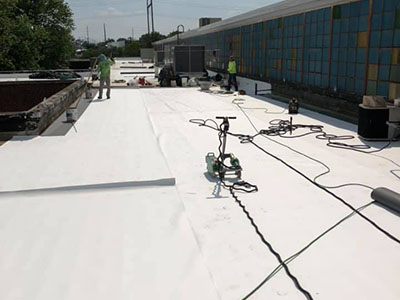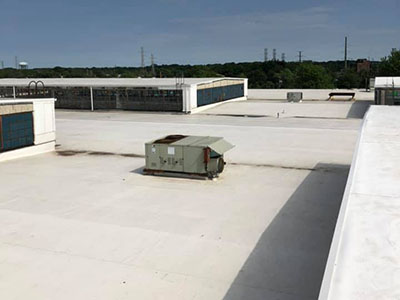One of the most popular roofing systems for flat or low-slope commercial buildings is the single-ply membrane system. Membranes work well for a variety of projects including exposed roofs, ballasted roofs, cool roofs, and even green roof technologies.
Lightweight and cost-effective, they are quickly installed and appropriate for commercial projects of any size, as well as many residential properties.
What is a Single-Ply Membrane?
Single-ply membranes are flexible sheets of a synthetic polymer. The sheets are rolled across your existing flat roof system. They are attached by either mechanical fasteners, chemically adhered or ballasted with rock.
The seams between the sheets are either chemically adhered (glued) together or heat-welded, depending on the material selected.
Single-ply membranes can be divided into 2 primary groups, thermoplastics and synthetic rubber. The most common single-ply systems are TPO, PVC and EPDM.
TPO. With a technical name like Thermoplastic Polyolefin, is there any wonder the industry simply calls it TPO?
As you can tell, TPO falls within the thermoplastic group. The benefit of a thermoplastic is the ability to be reheated and remolded. This has made them the number one option for many flat roof installations.
With a lifespan of 20-30 years with appropriate maintenance, TPO is a cost-effective way to extend the life of your roof and improve the waterproofing capabilities.
TPO membranes are well suited for just about any business or industrial application, with very few exceptions.
PVC. Polyvinyl Chloride, or PVC, is comparable to TPO in many respects. It is applied to your roofing structure in the same fashion. With a breaking strength of 350 pounds per square inch, it is extremely strong and durable.
PVC has a lifespan up to 30 years with appropriate maintenance. Though more expensive on the initial installation than TPO, the additional expense can be offset with the increased longevity.
Resistant to chemicals, water leaks, UV rays and fire, PVC is a great roofing system for applications where those issues are of concern.
Both TPO and PVC are highly reflective, reducing solar heat to the roofing system up to 80%. This reflectivity keeps the interior of the building more comfortable and saves money on cooling costs.
EPDM. Ethylene propylene diene terpolymer, also known as EPDM or “rubber roofing”, comes in sheets just like the other single-ply membrane systems. EPDM is a synthetic rubber option with the two primary ingredients, ethylene and propylene, being derived from oil and natural gas.
EPDM is attached to the roofing structure with the same methods as other single-ply membrane systems. However, the seams are either glued or taped together, rather than the heat-welding option.
Less expensive than TPO or PVC, EPDM is durable and flexible. It can accommodate temperature fluctuations ranging from -58° to 302°F.
EPDM has an average lifespan of around 20 years, which can be extended with restorations and proper maintenance.
Historically available in black only, recent interest in cool roof technology has led to the development of a white version, offering the same reflectivity benefit of the other single-ply membrane roofing systems.
For more information on single-ply membrane roofing options, or to schedule a consultation to discuss which option works best for you, call our team at 908-319-5952. We look forward to speaking with you soon.



